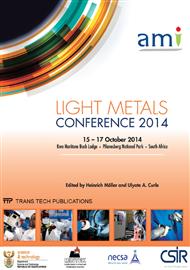p.204
p.210
p.218
p.225
p.231
p.241
p.248
p.254
p.259
Process Models for Press-and-Sinter Titanium
Abstract:
Two commercially pure (CP) titanium powders, with mean particle sizes of 78 and 32 μm, respectively, were used to manufacture titanium samples via the press-and-sinter powder metallurgy process. Compaction pressures ranging from 300 to 500 MPa were used to compact the powders into cylindrical and rectangular forms. The green samples were sintered for 2 hours under high vacuum, 10-6 mbar, at 1100, 1200 and 1300 °C, respectively. Green density and green strength data were collected from the compacted samples, and sintered density, sintered strength and microstructure images were collected from the sintered samples. These data were used to characterise process models for the compressibility of the powders, and for the sinter densification, using the Master Sintering Curve (MSC) model. The results show that particle size influences the processing at both the compaction and sintering step. In modelling these two processes, separate MSC models must be characterised and each used individually to predict each one’s final sintered density. It is shown that if the densification parameter is used to characterise the sintering model, a unified Master Densification Curve (MDC) is found. The modified MDC model can be used to predict the final sintered density regardless of the initial green density or mean particle size of the powder.
Info:
Periodical:
Pages:
231-240
Citation:
Online since:
October 2014
Authors:
Keywords:
Price:
Сopyright:
© 2014 Trans Tech Publications Ltd. All Rights Reserved
Share:
Citation:


